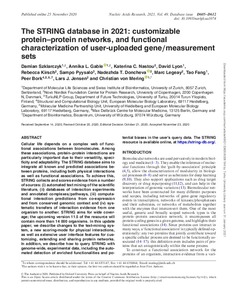The STRING database in 2021: customizable protein–protein networks, and functional characterization of user-uploaded gene/measurement sets
Szklarczyk Damian; Gable Annika L; Nastou Katerina C; Lyon David; Kirsch Rebecca; Pyysalo Sampo; Doncheva Nadezhda T; Legeay Marc; Fang Tao; Bork Peer; Jensen Lars J; von Mering Christian
https://urn.fi/URN:NBN:fi-fe2021042823829
Tiivistelmä
Cellular life depends on a complex web of functional associations between biomolecules. Among these associations, protein–protein interactions are particularly important due to their versatility, specificity and adaptability. The STRING database aims to integrate all known and predicted associations between proteins, including both physical interactions as well as functional associations. To achieve this, STRING collects and scores evidence from a number of sources: (i) automated text mining of the scientific literature, (ii) databases of interaction experiments and annotated complexes/pathways, (iii) computational interaction predictions from co-expression and from conserved genomic context and (iv) systematic transfers of interaction evidence from one organism to another. STRING aims for wide coverage; the upcoming version 11.5 of the resource will contain more than 14 000 organisms. In this update paper, we describe changes to the text-mining system, a new scoring-mode for physical interactions, as well as extensive user interface features for customizing, extending and sharing protein networks. In addition, we describe how to query STRING with genome-wide, experimental data, including the automated detection of enriched functionalities and potential biases in the user's query data. The STRING resource is available online, at https://string-db.org/.
Kokoelmat
- Rinnakkaistallenteet [27094]
